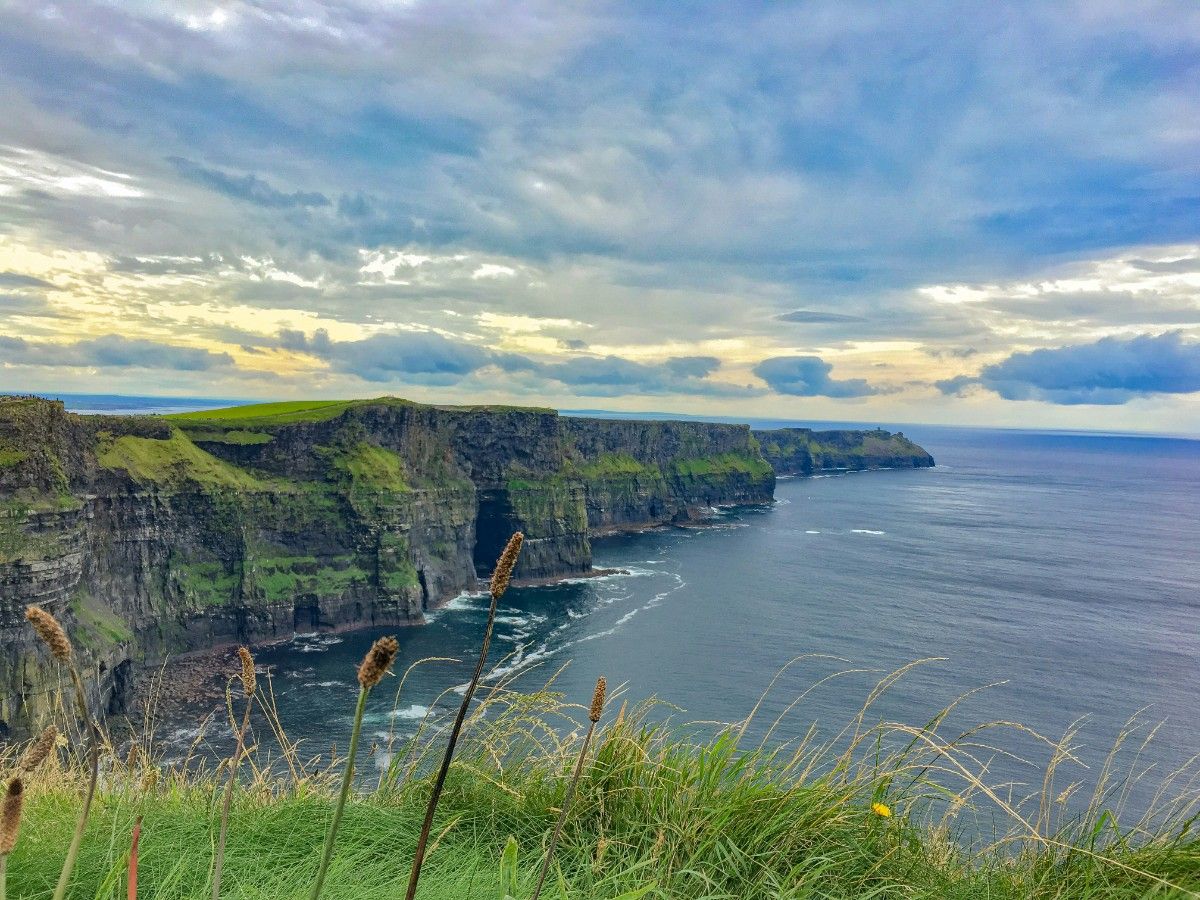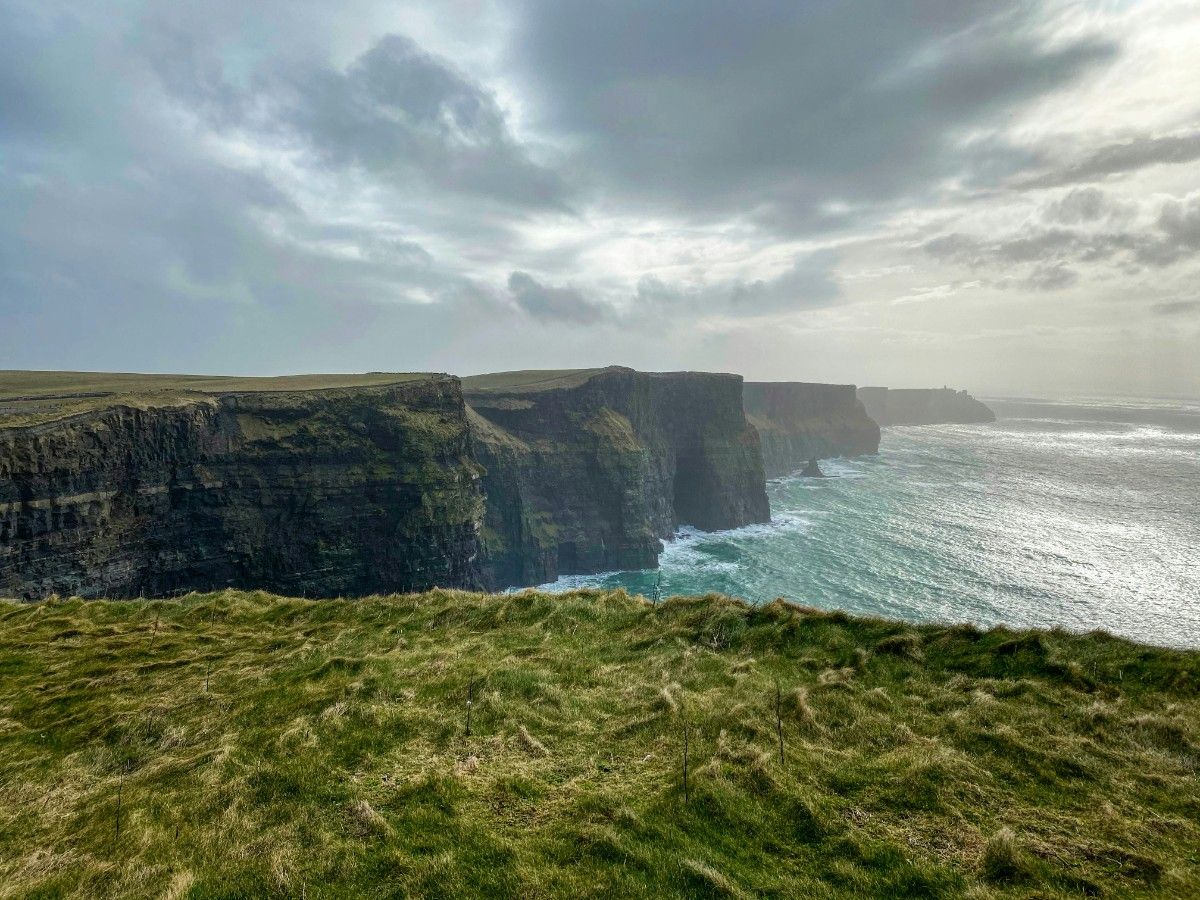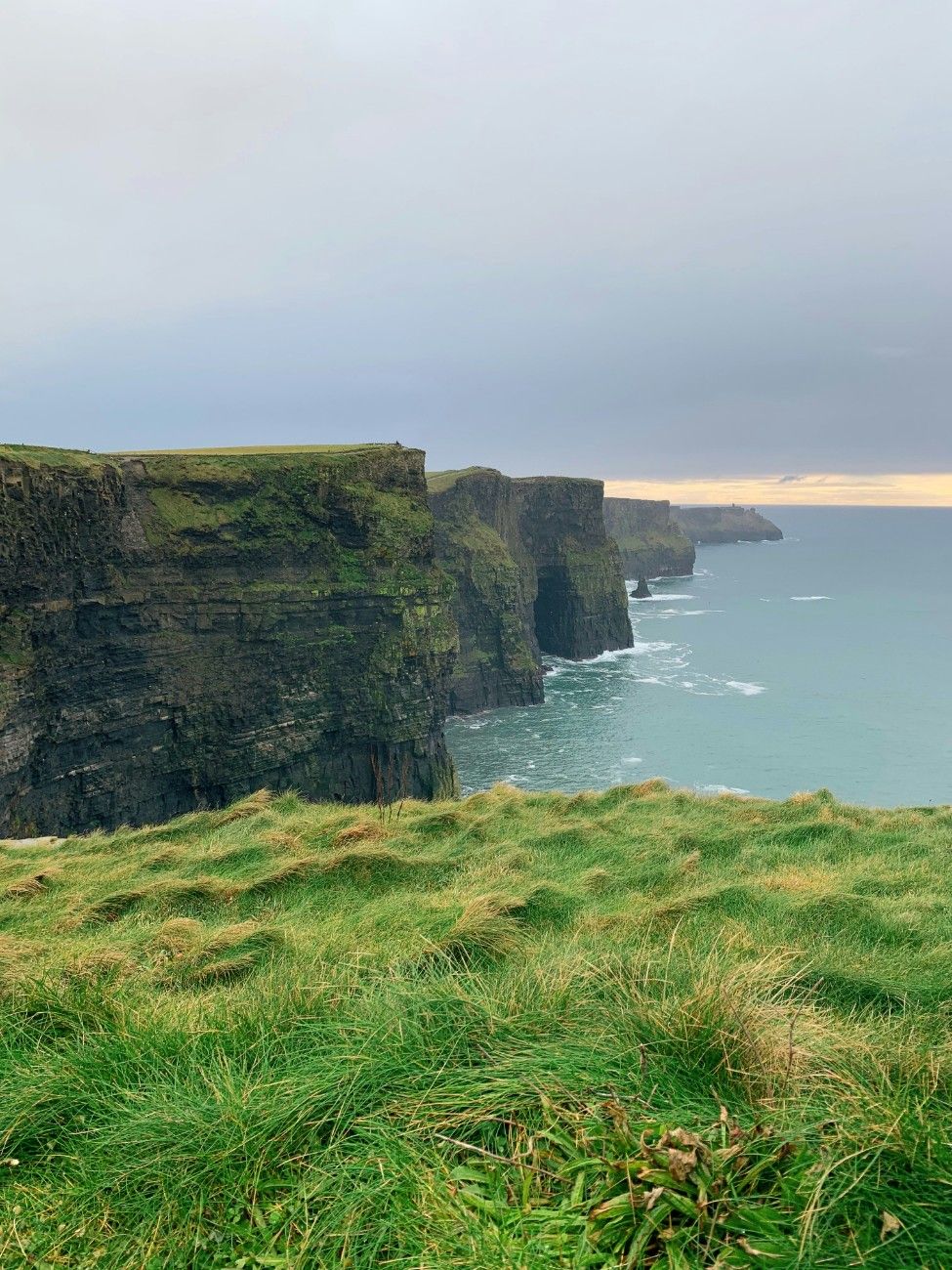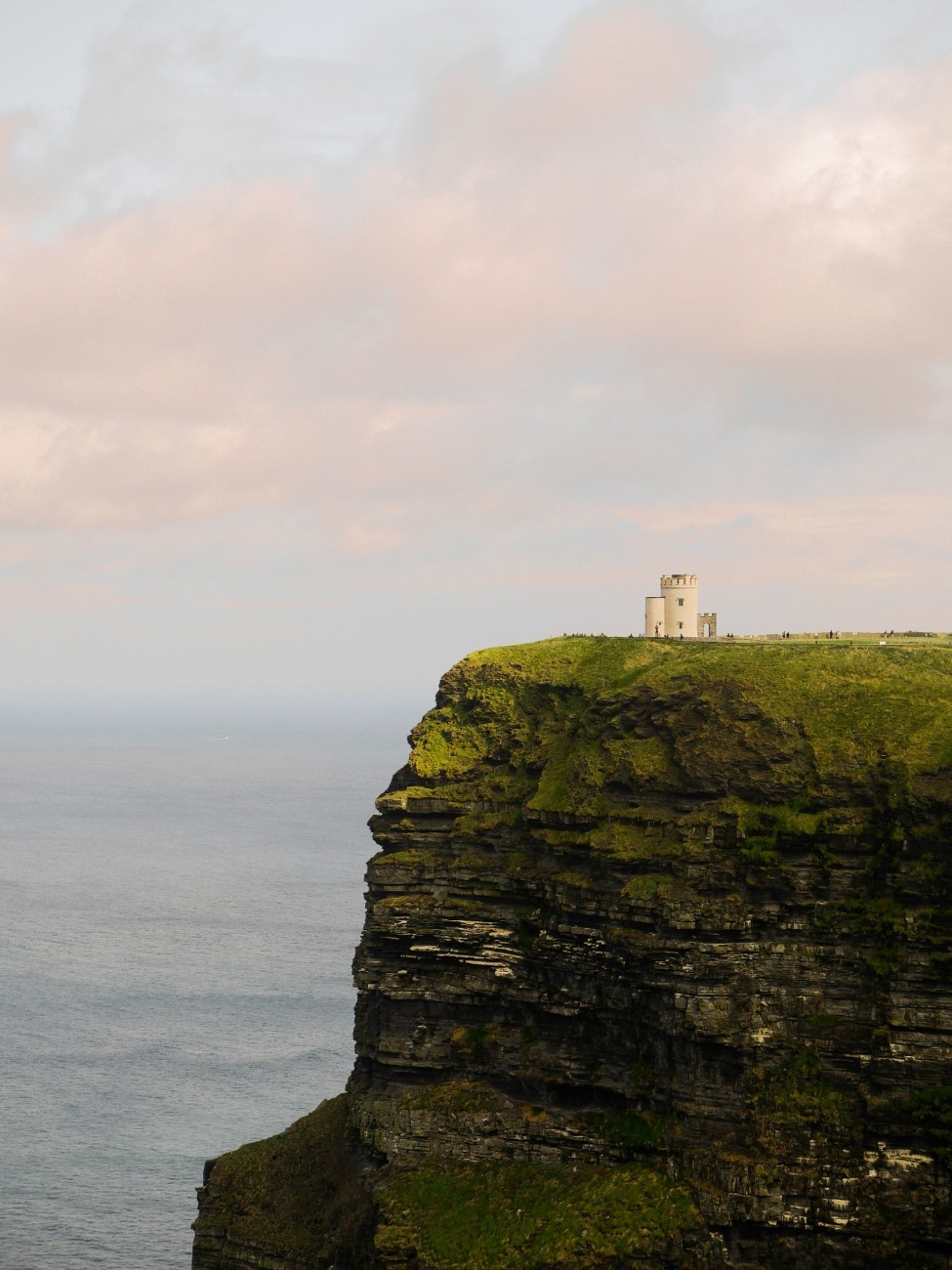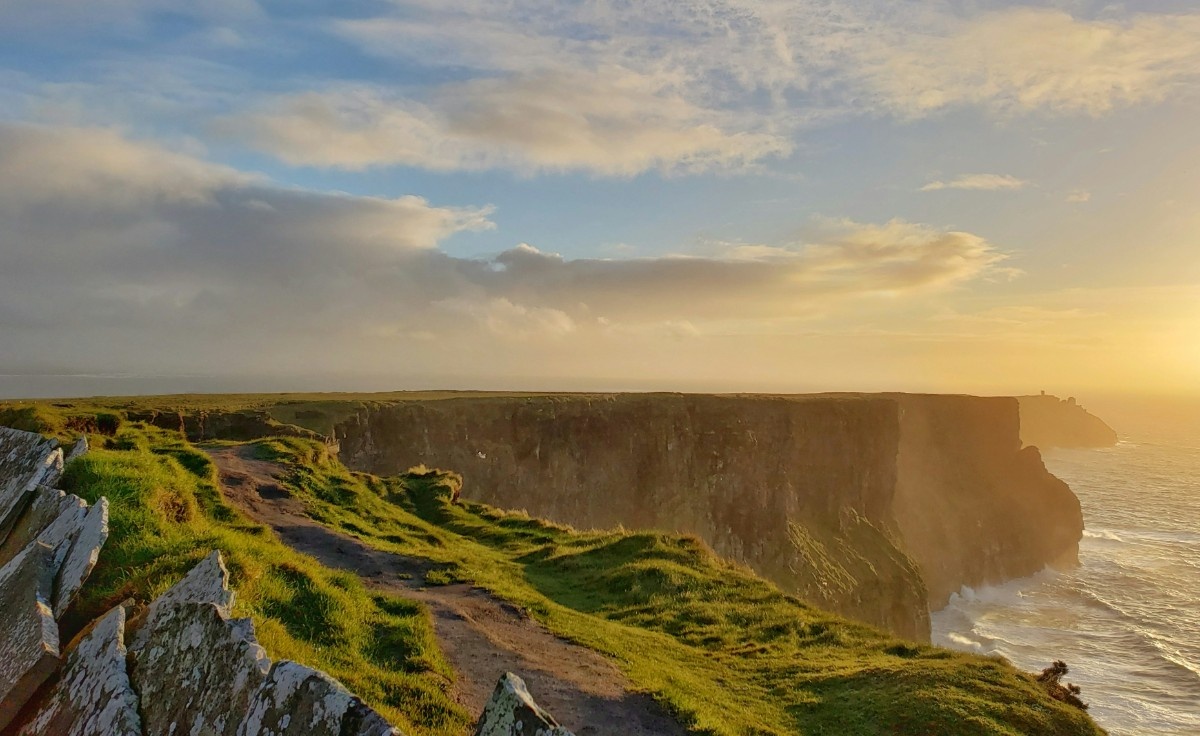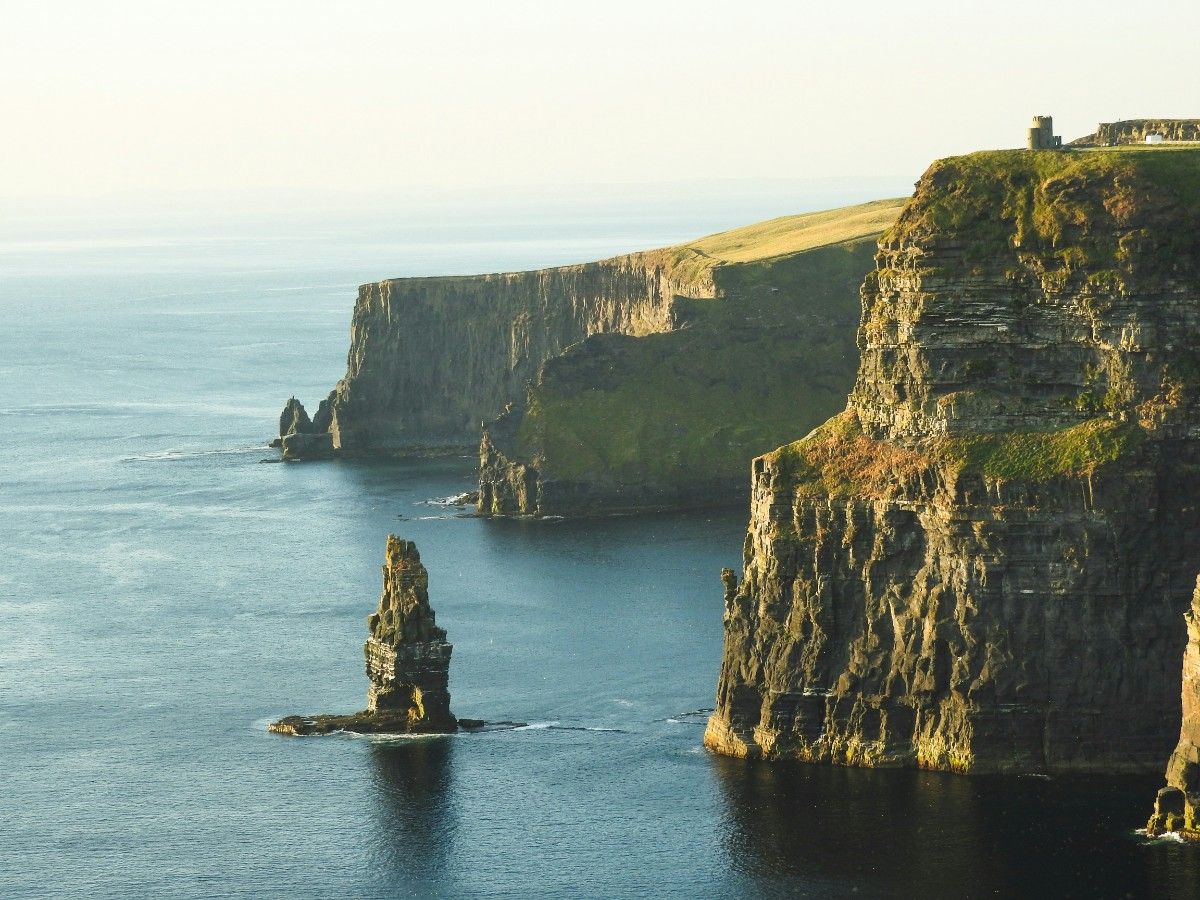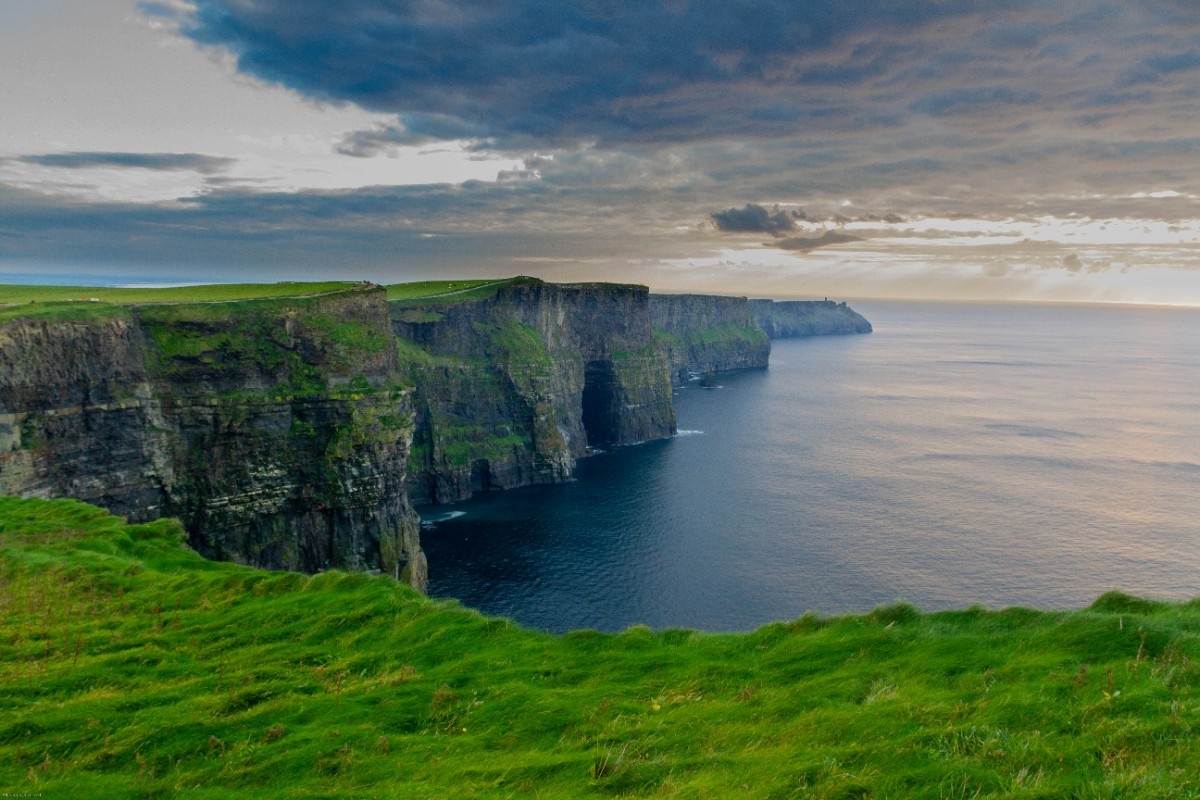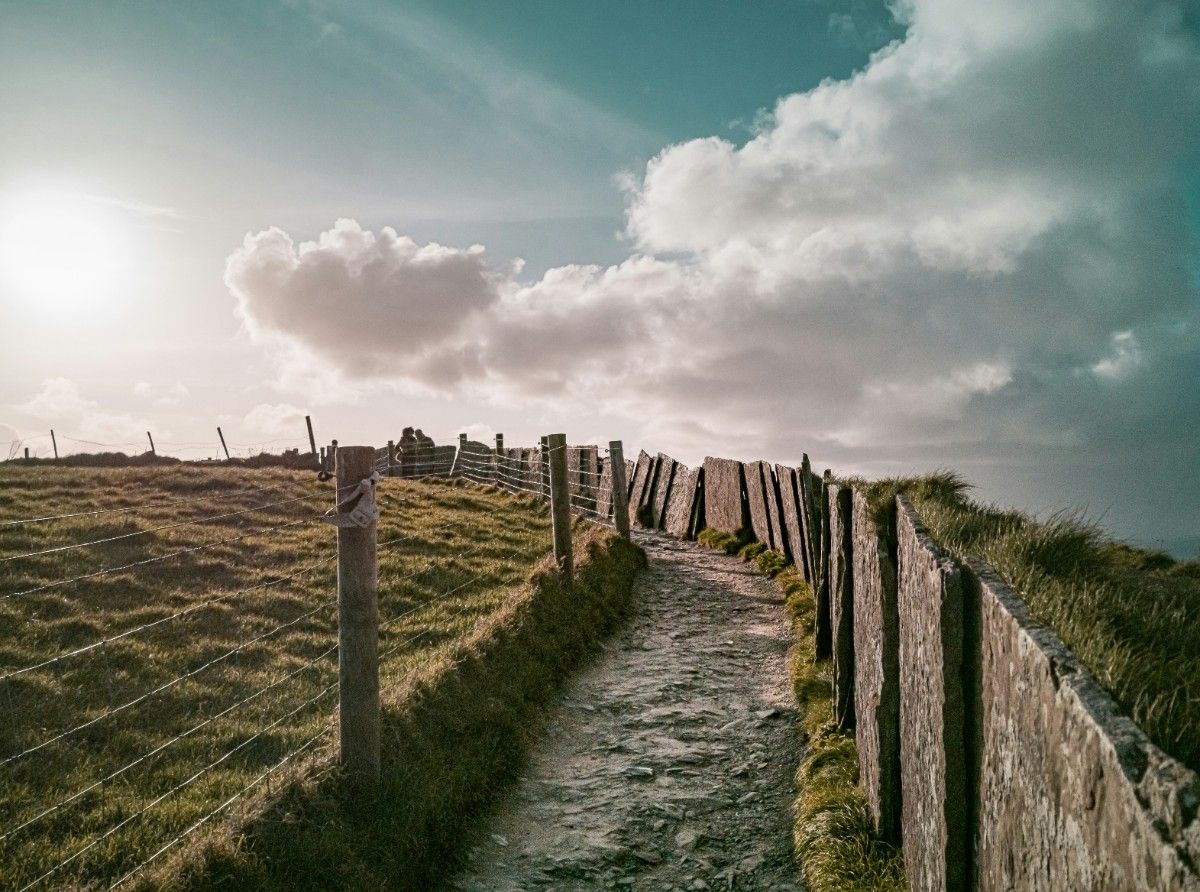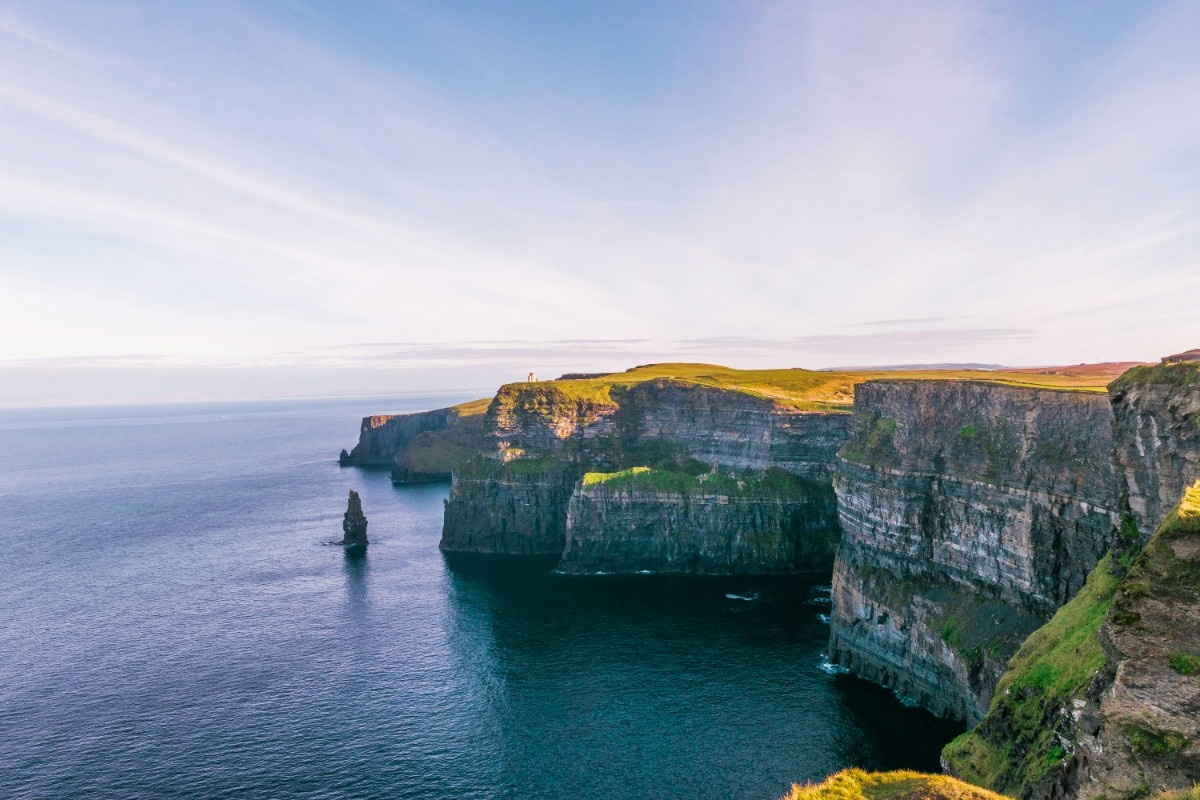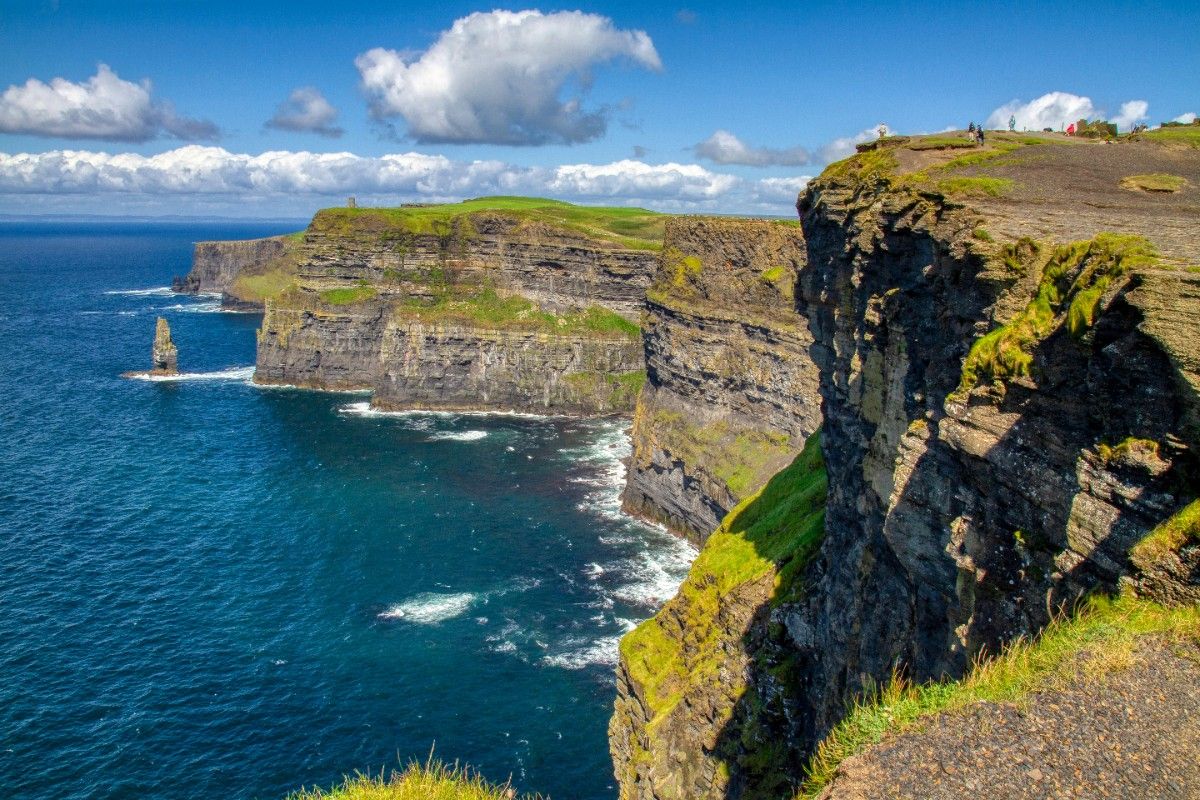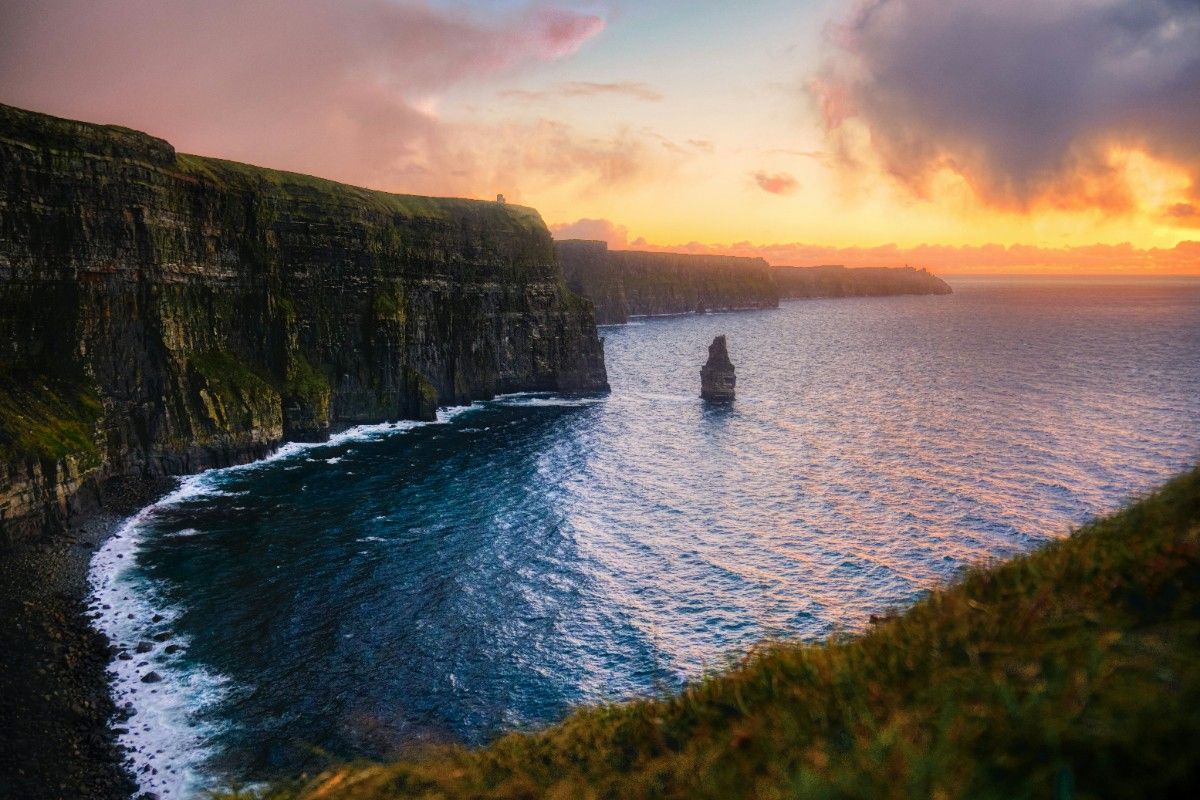Introduction to the Cliffs of Moher
Overview of the Cliffs
The Cliffs of Moher, located in County Clare, Ireland, are one of the country's most iconic and breathtaking natural wonders. These majestic cliffs stretch for approximately 14 kilometres (8.7 miles) along the Atlantic coast, offering visitors a stunning view of the rugged Irish coastline. The cliffs reach a maximum height of 214 metres (702 feet) at their highest point, near O'Brien's Tower, providing a panoramic view of the vast ocean and the surrounding landscape.
The Cliffs of Moher are not only a visual spectacle but also a significant habitat for wildlife. The cliffs are home to an estimated 30,000 birds from over 20 different species, including puffins, guillemots, razorbills, and kittiwakes. The unique ecosystem of the cliffs also supports a diverse array of plant life, including rare and protected species such as the Burren Green moth and the Spring Gentian.
Naming and History
The name "Cliffs of Moher" comes from the Irish word "Mothar," which translates to "ruined fort." This name refers to the remains of a promontory fort that once stood at Hag's Head, the southernmost point of the cliffs. The fort, believed to have been built during the early Christian period, served as a strategic lookout point and defensive structure for the local inhabitants.
Throughout history, the Cliffs of Moher have been a source of inspiration for artists, poets, and musicians. The cliffs have also played a role in popular culture, featuring in numerous films, television shows, and music videos. Perhaps most famously, the cliffs were featured in the Harry Potter film series, serving as a backdrop for a memorable scene in "Harry Potter and the Half-Blood Prince."
UNESCO Global Geopark Status
In recognition of their geological significance and the efforts to promote sustainable development and education in the area, the Cliffs of Moher were designated as a UNESCO Global Geopark in 2011. The cliffs form part of the Burren and Cliffs of Moher Geopark, which covers an area of over 530 square kilometres. This designation highlights the importance of the cliffs not only as a tourist attraction but also as a valuable scientific and educational resource.
The Geopark status also emphasises the need for responsible tourism and conservation efforts to protect the delicate ecosystem of the cliffs. The Cliffs of Moher Visitor Experience, in partnership with local and national organisations, has implemented various measures to minimise the impact of tourism on the environment, such as designated walking trails, protective barriers, and educational initiatives to raise awareness about the importance of preserving this natural wonder for future generations.
Geological Formation and History
Formation During the Upper Carboniferous Period
The story of the Cliffs of Moher begins over 320 million years ago, during the Upper Carboniferous period. At this time, the area that is now County Clare was part of a vast river delta, with sediments being deposited by ancient rivers flowing from the uplands to the south. These sediments, comprising sand, silt, and mud, gradually accumulated and were compressed and cemented over millions of years, forming the layers of shale and sandstone that make up the cliffs today.
The alternating layers of hard sandstone and softer shale that characterise the Cliffs of Moher are a result of the cyclical nature of sediment deposition in the ancient river delta. The harder sandstone layers represent periods when the flow of water was faster and more turbulent, allowing for the deposition of coarser sediments. The softer shale layers, on the other hand, were formed during periods of slower water flow, when finer sediments could settle and accumulate.
Shaping by Glacial Activity
While the foundation of the Cliffs of Moher was laid down during the Upper Carboniferous period, the cliffs as we see them today were largely shaped by more recent glacial activity during the Pleistocene epoch, which began approximately 2.6 million years ago. During this time, Ireland experienced several ice ages, with massive glaciers advancing and retreating across the landscape, carving out valleys, shaping mountains, and sculpting the coastline.
As the glaciers moved across the County Clare landscape, they exerted immense pressure on the underlying rock layers. The harder sandstone layers were more resistant to erosion, while the softer shale layers were more easily carved away. This differential erosion process resulted in the distinctive stepped appearance of the Cliffs of Moher, with the vertical sandstone cliffs separated by gentler slopes of shale.
The movement of the glaciers also contributed to the formation of unique geological features along the Cliffs of Moher, such as sea stacks, arches, and sea caves. These features were created as the glaciers eroded the cliffs and the relentless action of the waves further sculpted the weakened rock.
Post-Glacial Erosion and Weathering
Following the end of the last ice age, approximately 12,000 years ago, the Cliffs of Moher have continued to be shaped by ongoing erosion and weathering processes. As sea levels rose and the Atlantic Ocean encroached upon the land, the cliffs became subject to the constant pounding of waves and the erosive power of the sea.
The relentless action of the waves continues to erode the base of the cliffs, particularly the softer shale layers. As these layers are worn away, the overlying sandstone layers become undercut, leading to occasional collapses and rockfalls. This process, combined with the effects of wind, rain, and frost weathering, has resulted in the gradual retreat of the Cliffs of Moher over time, with an estimated rate of erosion of about 1 to 2 centimetres per year.
The ongoing process of erosion and weathering at the Cliffs of Moher serves as a reminder of the dynamic nature of the Earth's landscapes and the powerful forces that shape them over millions of years. As we marvel at the beauty and grandeur of these cliffs, we bear witness to a geological story that continues to unfold, one that speaks to the delicate balance between the enduring strength of rock and the relentless power of the elements.
Flora and Fauna
Unique Habitats and Ecosystems
The Cliffs of Moher are not only a geological wonder but also a haven for a diverse array of flora and fauna. The cliffs provide a unique habitat for various plant and animal species, some of which are rare or endemic to the area. The ecosystem of the cliffs is characterised by the harsh conditions created by the strong winds, salt spray, and thin soils, which have given rise to a distinctive community of plants and animals adapted to these challenges.
The cliff face itself is largely devoid of vegetation due to the extreme conditions, but the upper reaches of the cliffs and the adjacent grasslands support a surprising variety of plant life. The thin, well-drained soils on the cliff tops are home to a range of wildflowers, including the delicate spring squill, the vibrant pink thrift, and the aromatic wild thyme. These hardy plants have evolved to withstand the constant buffeting of the wind and the salt spray from the ocean below.
The grasslands atop the cliffs also provide a valuable habitat for invertebrates, such as the rare and protected Burren Green moth. This species is endemic to the Burren region of County Clare and relies on the unique flora of the area for its survival. The presence of such rare and specialised species highlights the ecological importance of the Cliffs of Moher and the need for ongoing conservation efforts.
Birdlife and Seabird Colonies
One of the most striking features of the Cliffs of Moher's ecosystem is the abundance and diversity of birdlife. The cliffs are home to an estimated 30,000 birds from over 20 different species, making it one of the most important seabird colonies in Ireland. The birds are attracted to the cliffs by the ample nesting sites provided by the ledges and crevices of the rock face, as well as the rich feeding grounds in the waters below.
Among the most numerous residents of the cliffs are the guillemots, razorbills, and kittiwakes. These seabirds arrive at the cliffs in the spring to breed and rear their young, filling the air with their raucous calls and the flutter of their wings. Visitors to the cliffs can also spot the colourful Atlantic puffin, with its distinctive orange beak and feet, nesting in burrows on the grassy slopes above the cliff face.
The Cliffs of Moher are also an important habitat for the chough, a rare and protected member of the crow family. Choughs are easily recognisable by their glossy black plumage, curved red beak, and distinctive red legs. The cliffs are one of the few remaining strongholds for this species in Ireland, and conservation efforts are ongoing to ensure their continued survival.
Marine Life and Ocean Ecosystems
While the birdlife of the Cliffs of Moher is perhaps the most visible and celebrated aspect of its ecosystem, the waters below the cliffs are also teeming with life. The nutrient-rich upwellings from the deep ocean support a diverse array of marine species, from tiny plankton to the larger fish, dolphins, and whales that feed upon them.
The waters around the Cliffs of Moher are particularly known for their populations of seabirds and marine mammals. Visitors to the cliffs may be lucky enough to spot a pod of dolphins or even a breaching humpback whale during the summer months. The cliffs also provide a vantage point for observing the annual migration of basking sharks, the second-largest shark species in the world, which can sometimes be seen feeding on plankton near the surface of the water.
The health and productivity of the marine ecosystem around the Cliffs of Moher are intricately linked to the health of the global ocean. The cliffs serve as a reminder of the interconnectedness of terrestrial and marine environments and the importance of protecting and conserving these valuable resources for future generations.
Tourism and Visitor Experience
Popularity and Visitor Numbers
The Cliffs of Moher are one of Ireland's most popular tourist destinations, attracting over 1.5 million visitors annually from around the world. The cliffs have become an iconic symbol of the Irish landscape and a must-see attraction for anyone visiting the Emerald Isle. The dramatic vistas, rugged coastline, and stunning natural beauty of the cliffs have captivated the hearts and minds of visitors for generations.
The popularity of the Cliffs of Moher has grown steadily over the years, with visitor numbers increasing from around 200,000 in the early 1990s to over 1.5 million in recent years. This growth in tourism has brought both opportunities and challenges for the local community and the management of the cliffs. While the economic benefits of tourism are significant, there is also a need to balance visitor numbers with the protection and conservation of the delicate ecosystem and natural heritage of the area.
Visitor Facilities and Amenities
To accommodate the large number of visitors to the Cliffs of Moher and to provide a high-quality visitor experience, a range of facilities and amenities have been developed at the site. The centrepiece of these facilities is the Cliffs of Moher Visitor Experience, a state-of-the-art interpretive centre that opened in 2007.
The visitor centre is built into the hillside, blending seamlessly with the natural landscape and offering stunning views of the cliffs and the Atlantic Ocean. Inside, visitors can explore a range of interactive exhibits and displays that showcase the geology, ecology, and cultural heritage of the Cliffs of Moher. The centre also includes a gift shop, a café serving locally sourced food and refreshments, and a range of visitor services such as restrooms and information desks.
In addition to the visitor centre, there are a number of other amenities and facilities available at the Cliffs of Moher. These include a network of walking trails and viewing platforms that allow visitors to explore the cliffs at their own pace and take in the breathtaking views. The trails are well-maintained and offer a range of options for visitors of all ages and abilities, from short, accessible walks to longer hikes along the cliff tops.
Guided Tours and Experiences
For those looking for a more immersive and educational experience, the Cliffs of Moher also offer a range of guided tours and experiences. These tours are led by knowledgeable local guides who provide insights into the geology, ecology, and history of the cliffs, as well as the stories and legends associated with this iconic landscape.
One popular option is the Cliffs of Moher Coastal Walk, a guided hike along the cliff tops that takes visitors from the main visitor centre to the nearby village of Doolin. Along the way, guides share their knowledge of the area's natural and cultural heritage, pointing out important geological features, rare plant and animal species, and historic sites such as the ruins of the promontory fort at Hag's Head.
Other guided experiences include boat tours of the cliffs from the water, allowing visitors to appreciate the scale and grandeur of the cliffs from a unique perspective. These tours also offer the chance to see the cliffs' resident seabird colonies up close and to learn about the marine life that inhabits the waters below.
Sustainable Tourism and Conservation
As one of Ireland's most popular tourist attractions, the Cliffs of Moher face the ongoing challenge of balancing visitor numbers and experiences with the protection and conservation of the natural environment. In recent years, there has been a growing emphasis on sustainable tourism practices and initiatives at the cliffs, aimed at minimising the impact of visitors on the delicate ecosystem and preserving the natural heritage of the area for future generations.
The Cliffs of Moher Visitor Experience has implemented a range of measures to promote sustainable tourism, including the use of renewable energy sources, the promotion of recycling and waste reduction, and the use of locally sourced materials and products in its facilities. The visitor centre has also been designed to blend seamlessly with the natural landscape, minimising its visual impact on the surrounding environment.
In addition to these initiatives, the management of the Cliffs of Moher has also worked to promote responsible visitor behaviour and to educate visitors about the importance of conservation. This includes the development of a code of conduct for visitors, which emphasises the need to stay on designated trails, respect wildlife and habitats, and take steps to minimise environmental impact.
The sustainable tourism practices and conservation efforts at the Cliffs of Moher are part of a broader commitment to protecting and preserving Ireland's natural heritage. By promoting responsible tourism and educating visitors about the importance of conservation, the Cliffs of Moher serve as a model for how popular tourist destinations can balance the needs of visitors with the protection of the environment.
Cultural Significance and Legends
Ancient Legends and Folklore
The Cliffs of Moher have long been a source of inspiration for Irish folklore and legends. These stories, passed down through generations, have become an integral part of the cultural heritage of the region. One of the most famous legends associated with the cliffs is that of the "Mermaid of Moher."
According to the legend, a beautiful mermaid named Moher fell in love with a local fisherman named Cú Chulainn. However, their love was ill-fated, as Cú Chulainn was a mortal man and Moher was a creature of the sea. Unable to bear the thought of living without her beloved, Moher threw herself from the cliffs, never to be seen again. It is said that on quiet nights, the haunting sound of her singing can still be heard echoing through the cliffs, serving as a reminder of their tragic love story.
Another popular legend tells the tale of the "Hag of Moher," a fearsome witch who was said to have lived in a cave at the base of the cliffs. According to the legend, the Hag would lure unsuspecting travellers to her cave with the promise of shelter and food, only to trap them there for eternity. The story serves as a cautionary tale, warning of the dangers that lurk beneath the beauty of the cliffs.
Artistic Inspiration and Cultural References
Beyond their role in Irish folklore, the Cliffs of Moher have also served as a source of inspiration for countless artists, writers, and musicians. The rugged beauty and dramatic vistas of the cliffs have been captured in paintings, photographs, and literary works for generations.
One of the most famous cultural references to the Cliffs of Moher can be found in the Harry Potter film series. In "Harry Potter and the Half-Blood Prince," the cliffs serve as the backdrop for a pivotal scene in which Harry and Dumbledore search for one of Voldemort's horcruxes. The scene showcases the stunning beauty of the cliffs and has helped to introduce them to a new generation of fans around the world.
The cliffs have also been referenced in numerous songs and musical compositions, including the traditional Irish song "The Cliffs of Moher" and the instrumental piece "The Cliffs of Moher" by Irish composer Seán Ó Riada. These musical tributes to the cliffs reflect their enduring significance in Irish culture and their ability to inspire and move people through the power of art and music.
Significance in Irish Identity and Heritage
For the people of Ireland, the Cliffs of Moher are more than just a natural wonder or a tourist attraction. They are a symbol of Irish identity and a testament to the enduring spirit of the Irish people. The cliffs have borne witness to the history of Ireland, from the ancient Celtic tribes who first settled the land to the modern-day visitors who come from around the world to marvel at their beauty.
The Cliffs of Moher are also a source of pride for the local community in County Clare. Many local families have lived in the area for generations, and the cliffs are an integral part of their cultural heritage and way of life. The tourism industry that has grown up around the cliffs has provided employment and economic opportunities for the region, helping to sustain the local community and preserve their traditional way of life.
In recent years, there has been a growing recognition of the importance of protecting and preserving the cultural heritage of the Cliffs of Moher. This has led to the development of educational programs and initiatives aimed at promoting a deeper understanding and appreciation of the cliffs and their significance in Irish culture. By engaging visitors and local communities in the story of the cliffs, these programs help to ensure that their cultural legacy will endure for generations to come.
Nearby Attractions and Accommodations
The Burren Region
Located just a short drive from the Cliffs of Moher, the Burren region is a unique and fascinating landscape that is well worth exploring. The Burren is characterised by its vast expanses of limestone pavement, which have been carved and sculpted by the forces of nature over millions of years. The region is home to an incredible diversity of plant and animal life, including many rare and endangered species.
Visitors to the Burren can explore the region's many walking trails and hiking routes, which offer stunning views of the landscape and the opportunity to discover its hidden gems. Some of the most popular attractions in the Burren include the Aillwee Cave, a stunning underground cavern that features a waterfall and a variety of rock formations, and the Poulnabrone Dolmen, an ancient burial site that dates back over 5,000 years.
For those interested in the history and culture of the region, the Burren Centre in Kilfenora offers a range of exhibitions and interactive displays that showcase the unique geology, ecology, and archaeology of the Burren. The centre also serves as a gateway to the wider Burren region, providing information and resources for visitors looking to explore the area further.
Doolin Village and the Aran Islands
Just a few kilometres down the coast from the Cliffs of Moher lies the charming village of Doolin. Known as the traditional music capital of Ireland, Doolin is a must-visit destination for anyone interested in experiencing authentic Irish culture and hospitality. The village is home to a number of lively pubs and restaurants, where visitors can enjoy traditional Irish music sessions and sample the best of local cuisine.
Doolin is also the gateway to the Aran Islands, a group of three islands located off the coast of County Clare. The islands are known for their rugged beauty, ancient history, and unique cultural heritage. Visitors can take a ferry from Doolin to the islands, where they can explore ancient stone forts, visit traditional craft workshops, and experience the islands' stunning natural beauty.
The largest of the Aran Islands, Inishmore, is home to the famous Dún Aonghasa, a prehistoric fort that sits atop a cliff edge overlooking the Atlantic Ocean. The fort is a testament to the ingenuity and skill of the ancient Irish people, and offers stunning views of the surrounding landscape.
Liscannor and Lahinch
For those looking to stay in the area around the Cliffs of Moher, the nearby towns of Liscannor and Lahinch offer a range of accommodation options to suit every budget and preference. From cozy bed and breakfasts to luxurious hotels, there is something for everyone in these charming coastal communities.
Liscannor, located just a few kilometres from the Cliffs of Moher, is a small but vibrant town that is known for its friendly locals and stunning coastal views. The town is home to a number of excellent restaurants and pubs, as well as a range of shops and galleries showcasing the work of local artisans.
Lahinch, located just a little further down the coast, is a popular destination for surfing and other water sports. The town's long sandy beach and consistent waves make it a mecca for surfers from around the world. Lahinch is also home to a championship golf course, as well as a range of other outdoor activities and attractions.
The Wild Atlantic Way
The Cliffs of Moher are just one of the many stunning destinations along Ireland's Wild Atlantic Way, a 2,500 km coastal route that stretches from the northern tip of the country to the southern coast. The route offers visitors the opportunity to explore some of Ireland's most spectacular natural wonders, from the rugged cliffs and pristine beaches of the west coast to the lush green hills and valleys of the interior.
Along the way, visitors can experience the best of Irish culture and hospitality, with a range of towns and villages offering everything from traditional music and dance to world-class dining and accommodation. The Wild Atlantic Way is a true showcase of the best that Ireland has to offer, and a must-visit destination for anyone looking to experience the beauty and culture of this incredible country.
Preservation and Conservation Efforts
Sustainable Tourism Initiatives
As one of Ireland's most popular tourist destinations, the Cliffs of Moher face significant challenges in balancing the needs of visitors with the protection and preservation of the natural environment. In recent years, there has been a growing recognition of the importance of sustainable tourism practices in ensuring the long-term health and viability of the cliffs and the surrounding ecosystem.
The Cliffs of Moher Visitor Experience has been at the forefront of these efforts, implementing a range of initiatives aimed at promoting sustainable tourism and minimising the impact of visitors on the environment. One of the key strategies has been the development of a network of designated walking trails and viewing platforms, which help to manage visitor flow and prevent erosion and damage to the delicate vegetation on the cliff tops.
The visitor centre itself has also been designed with sustainability in mind, incorporating a range of eco-friendly features such as a rainwater harvesting system, energy-efficient lighting, and a green roof that helps to regulate temperature and reduce the building's carbon footprint. The centre also promotes the use of reusable water bottles and encourages visitors to dispose of waste responsibly.
In addition to these practical measures, the Cliffs of Moher Visitor Experience has also been working to educate visitors about the importance of conservation and responsible tourism. This includes the development of educational programs and resources that highlight the unique ecology and geology of the cliffs, as well as the ongoing efforts to protect and preserve this incredible natural wonder.
Monitoring and Research Programs
To effectively manage and protect the Cliffs of Moher, it is essential to have a deep understanding of the complex ecological and geological processes that shape this unique environment. To this end, the Cliffs of Moher Visitor Experience has been working in partnership with a range of academic and scientific institutions to conduct ongoing monitoring and research programs at the site.
One of the key areas of focus has been the monitoring of seabird populations, which are a critical indicator of the health and productivity of the marine ecosystem around the cliffs. Researchers have been using a range of techniques, including GPS tracking and remote sensing, to study the behaviour and migration patterns of key species such as puffins, guillemots, and razorbills.
Another important area of research has been the study of coastal erosion and the impacts of climate change on the cliffs. As sea levels rise and storm surges become more frequent and intense, there is growing concern about the long-term stability of the cliffs and the potential for catastrophic collapse. By monitoring changes in the cliff face and conducting regular surveys of the surrounding coastline, researchers are working to develop predictive models and risk assessments that can inform management decisions and guide conservation efforts.
In addition to these targeted research programs, the Cliffs of Moher Visitor Experience also supports a range of citizen science initiatives that engage visitors and local communities in the ongoing monitoring and conservation of the site. These programs provide valuable data and insights that can help to inform management decisions and promote a deeper understanding and appreciation of the cliffs and their ecological significance.
Collaboration and Partnerships
Effective conservation and management of the Cliffs of Moher requires a collaborative approach that engages a wide range of stakeholders and partners. The Cliffs of Moher Visitor Experience has been working closely with local communities, government agencies, and conservation organisations to develop and implement strategies for the long-term protection and preservation of the site.
One of the key partnerships has been with the Burren and Cliffs of Moher UNESCO Global Geopark, which was established in 2011 to promote sustainable development and conservation in the region. The Geopark has been working to raise awareness of the unique geological and ecological significance of the Cliffs of Moher and to promote responsible tourism practices that support the local economy while minimising environmental impacts.
Another important partnership has been with the National Parks and Wildlife Service, which is responsible for the management and protection of Ireland's natural heritage. The service has been working closely with the Cliffs of Moher Visitor Experience to monitor and manage the site's wildlife populations and habitats, and to develop strategies for the long-term conservation of this incredible natural resource.
In addition to these formal partnerships, the Cliffs of Moher Visitor Experience has also been working to engage local communities and businesses in the ongoing conservation and management of the site. This includes the development of training and education programs for local tour operators and hospitality providers, as well as the promotion of local products and services that support sustainable tourism and economic development in the region.
In Summary
Reflecting on the Significance of the Cliffs of Moher
The Cliffs of Moher are a true natural wonder, a testament to the incredible power and beauty of the natural world. From their towering heights to their rich ecological diversity, the cliffs offer a unique and awe-inspiring experience that captures the hearts and minds of all who visit.
But the significance of the Cliffs of Moher goes far beyond their stunning visual appeal. As we have seen throughout this exploration, the cliffs are a complex and dynamic environment shaped by millions of years of geological processes and ecological interactions. They are a living laboratory, a window into the incredible complexity and resilience of the natural world.
At the same time, the Cliffs of Moher are also a deeply cultural and historical landscape, a place that has inspired countless legends, artworks, and stories throughout the centuries. From the ancient Celtic myths to the modern-day films and music that celebrate their beauty, the cliffs have played a central role in shaping Irish identity and culture.
Looking to the Future
As we look to the future, it is clear that the Cliffs of Moher will continue to face significant challenges and opportunities in the years ahead. With rising sea levels, increasing storm surges, and other impacts of climate change, the long-term stability and integrity of the cliffs are at risk. At the same time, the growing popularity of the site as a tourist destination brings its own set of challenges, from managing visitor impacts to ensuring the sustainability of the local economy.
To address these challenges, it will be essential to continue the collaborative and proactive approach to conservation and management that has been developed in recent years. This will require ongoing investment in research and monitoring programs, as well as the development of innovative solutions and partnerships that engage a wide range of stakeholders and communities.
Ultimately, the future of the Cliffs of Moher will depend on our ability to balance the needs of the present with the long-term health and resilience of this incredible ecosystem. By working together to protect and preserve this natural wonder, we can ensure that it continues to inspire and enrich the lives of generations to come.
A Call to Action
As we conclude this exploration of the Cliffs of Moher, it is important to recognise that we all have a role to play in the ongoing conservation and protection of this incredible site. Whether as visitors, residents, or stakeholders in the region, we each have a responsibility to act as stewards of this unique and fragile environment.
This means being mindful of our impact as tourists, staying on designated trails and viewing areas, and supporting local businesses and initiatives that prioritise sustainability and conservation. It means advocating for policies and practices that prioritise the long-term health and resilience of the cliffs and the surrounding ecosystem. And it means continuing to learn about and celebrate the incredible natural and cultural heritage of this special place.
In the end, the Cliffs of Moher are more than just a tourist attraction or a natural wonder. They are a reminder of the incredible beauty and complexity of the world we live in, and of our shared responsibility to protect and preserve it for future generations. By working together to steward this incredible resource, we can ensure that the Cliffs of Moher continue to inspire and enrich the lives of people around the world for generations to come.
Related Articles

Let us know you agree to cookies
We use marketing, analytical and functional cookies as well as similar technologies to give you the best experience. Third parties, including social media platforms, often place tracking cookies on our site to show you personalised adverts outside of our website.
We store your cookie preferences for two years and you can edit your preferences via ‘manage cookies’ or through the cookie policy at the bottom of every page. For more information, please see our cookie policy.
